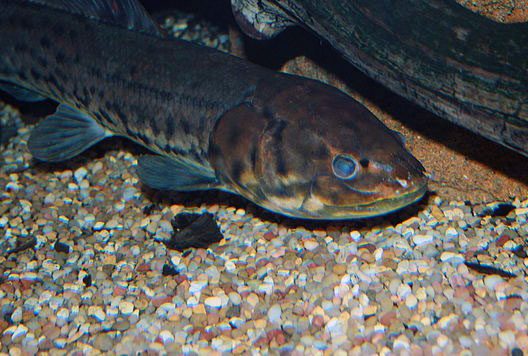The ancient bowfin – a unique fish

As you kayak along the Uwharrie River, you’ll likely see longnose gar. These strange dinosaur-like creatures are hard to miss, with their large size of 2 to 3 feet, their brownish olive coloring, and long narrow snout and sharp teeth. Another species related to the gar and found in some parts of the state, but less commonly here in central North Carolina, is the bowfin (Amia calva).
Like longnose gar, bowfins are also an ancient fish, sometimes also called grinnell (or grinnel or grindle), mudfish, dogfish, blackfish or mud pike, probably because they feed near the bottom of lakes, ponds, and rivers. They prefer slow-moving, lowland waters and are sometimes found in brackish water. They eat primarily other fish, mollusks and crayfish and prefer to stalk prey at night, attacking quickly and silently. Although they are distantly related to the gar, bowfin are unique –the only surviving species of the order Amiiformes that dates to the Jurassic period, more than 70 million years ago. As a result they are often called an ancient relic, or a “living fossil,” and are the focus of much scientific study.
Common in the eastern United States, they are native to North Carolina, though they are sometimes confused with exotic northern snakehead fish. Bowfin reach an average length of just under 2 feet, and they have a similar coloration to a gar, brownish-green with dark mottling. They do not have the gar’s long snout, but they do have sharp teeth, and their bodies are long and round. Bowfins get their name from their long dorsal fin, which extends down their back and goes all the way to their tail, and rolls back and forth as they swim. They are a ray-finned fish, which means their fins consist of webs of skin supported by bony spines.
Bowfin have several interesting characteristics, perhaps the most notable of which is that they are bimodal breathers, which means they have the ability to intake oxygen both from water and air. They have both gills and a swim bladder lung, the latter of which allows them to survive by breathing or gulping air if they are in waters with low oxygen, also known as hypoxic conditions. This gives them a benefit over other species that cannot survive such conditions.
Although their meat is only questionably palatable, some say they are good when smoked, but they are not classically thought of as a sport fish. They are a strong and muscular fish capable of quick movement though, and as such are known to put on a good fight for an angler. Because they eat other fish, they were once considered a threat for other game fish populations, but now are believed to be valuable as they take out the weaker and less preferable sport fish.
They tend to be more common in coastal areas of the state, and I have seen them in ponds at the Pee Dee Wildlife refuge, but would be interested to know if others have seen bowfin in the Uwharrie area or nearby (email me at crystal@landtrustcnc.org).
If you’re interested in seeing one of these “living fossils” in person, the N.C. Zoo in Asheboro has bowfin on exhibit. Stop by and check them out, and ponder all that the species has seen in their long existence, and the physical characteristics that allowed them to persist. We should do all we can to protect our water quality and wetland systems, to ensure this species is around for many more years to come.